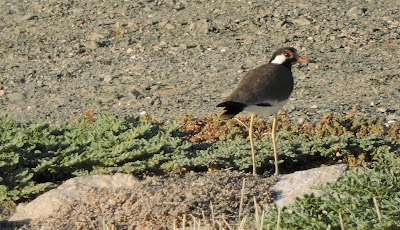Instead I booked a room in a hotel in Duqm for Tuesday night leaving a 180 kilometre stretch and the ferry for Wednesday.
I snatched small amounts of birding on both Tuesday afternoon and Wednesday morning en route. Furthermore I arrived on Masirah for 90 minutes birding on Wednesday evening. This blog covers the birding on these two days.
Indian pond heron at Sadah
I elected to take the coast road out on Tuesday and as the distance was so great (over 600 kilometres), I stopped briefly just twice before dark. The first stop was at the small park at Sadah. Here I came across an Indian pond heron which was hiding in a tree.
Greater sand plover at Hasik
The next short stop close to dusk was at Hasik. This area looks like it has good potential for water birds but time was brief. The best sighting was a flock of greater sand plover.
Pacific golden plover
The most common birds were steppe gull. There was a lone pacific golden plover. The highlight though was a masked booby flying over the water.
After this was a long haul drive into the night before reaching the City Hotel Duqm for rest.
The next day only required a further 180 kilometres so it was slightly more leisurely.
A stop at a random wadi about halfway to the ferry port produced my first (and only) white eared bulbul. This was a sure sign that I was in the northern half of the country. It is not a bird of Dhofar.
white eared bulbul
I diverted off the main road to the ferry port to take in Filim on the coast which has a massive wetland often called Bar al Hikman.
On my way there was distracted further by seeing a sign to Mahoot waste treatment site. Perhaps I should have ignored it but like exploration.
Ruff at Mahoot waste site
This site was as rough as any I have seen in the Middle East yet birds were attracted to it. There were several ruff and even two great cormorant.
great cormorant
In these dirty sites, looking at the structure of a bird is often necessary as old stains are regularly picked up.
black-winged stilt
northern pintail
Perhaps the biggest surprise at the waste site was the number of ducks, many of which were northern pintail.
whiskered tern
I spotted three terns there. I believe they were all whiskered tern. The long legs and strong bill on this bird is typical.
redshank (left) and grey plover (right)
The main reason for my diversion was to look for great knot on the wetland at Filim. This was the only failure on the trip. The light was very difficult, the distances to scan were vast and time was hurried. It wasn't difficult to find bar-tailed godwit with which great knot is known to associate. I counted more than twenty but there were dispersed. There was no one place for them.
After Filim I was on the ferry to Masirah by mid-afternoon.
on the ferry to Masirah
I kept looking out to sea but the only birds were steppe gull and sooty gull both on the water and in the skies.
sooty gull
great cormorant on a tree at Hilf
red-wattled lapwing
A red wattled lapwing greeted me on one of the over-spill pools.
lesser black-headed gull
The main pools were full of ducks and gulls. The gulls were a mix of slender-billed gull and lesser black-headed gull.
hoopoe
A single hoopoe flew to the safety of a tree.
One reason for making the very long trip to Masirah was the report of the country's first ever white-throated kingfisher. It had first been reported in early November and again until late November. However there was no guarantee it would still be there.
common kingfisher
I did come across a common kingfisher near the main pools quite quickly.
common kingfisher 2
In the same tree was the only water pipit I saw all the time I was on the island.
water pipit
It's distant cousin, white wagtail was much more common.
white wagtail
As dusk was setting in, I headed back out of the works only to see a cattle egret roost forming up.
cattle egret
Very nearly the last bird I meet on my way out was the white-throated kingfisher. It was a fleeting look and was most unsatisfactory as it disappeared through the trees. There were however two full days to find it and it was an good omen as to what was to come.






















No comments:
Post a Comment